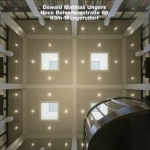Opus 80: Oswald Mathias Ungers, Haus Belvederestrasse 60, Koln-Mungersdorf
BookThis item doesn’t have any media yet
2016 | Architecture & Design
A house is a representation of the idea of the world, of life, of existence. For the Cologne architect Oswald Mathias Ungers (19262007), owner of a famous collection of books on architecture, who also repeatedly addressed the theoretical aspects of building, the construction of his own house, in 1958/59, was more than a private adventure. For him it meant a chance to gain spatial experience and explore what was possible. It was a laboratory, a little universe, a piece of world. In the course of his life, Ungers built himself and his family no less than three houses, two in the Cologne suburb of Mungersdorf, one in the Eifel highlands. Even the first house, to which this richly illustrated volume is dedicated, caused an international sensation; it was considered to be an important example of so-called Brutalism. It showed "everything I knew how to do at the time", Ungers wrote regarding the building. He wanted a house that enveloped and sheltered, he wanted metamorphosis and transformation; architecture that was autonomous but at the same time respected the genius loci. At the time, architects preferred to build their private homes as freestanding bungalows in the countryside.
Ungers, on the other hand, settled in a place where there were traces of the Roman past and purchased a plot of land adjacent to an already existing row of terraced houses. Three decades later, Ungers expanded the cataract of forms of his first home by adding a geometrically strict cube, intended to house his library. The shock aesthetics of the early work had evolved into the rigorous abstractness of his late work. This building too one of a kind, and in interplay with its predecessor became a manifesto. It corresponded to the idea of a house as a small town and the town as a large house, an idea that has run through European architectural history since Alberti. In spite of all their differences, the two contrasting formats make common cause. They show a world full of contradictions, illusions and realities that reflects the entire spectrum of the image of architecture, from the fiction to the reality of the function. Today the house and the library are the seat of the UAA, the Ungers Archiv fur Architekturwissenschaft, and open to the public. The architectural historian Wolfgang Pehnt often visited Ungers.
The author of an authoritative book about the architecture of Expressionism, he profited by Ungers collection of material back in the years when Ungers was still interested in Expressionism. Thus he is familiar with the house in its details and has witnessed its modifications. As portrayed by him, the history of the origins of the house gives access to the impressive uvre of a great German architect.
Related Items:
| Published by | Edition Axel Menges |
| Edition | Unknown |
| ISBN | 9783932565809 |
| Language | N/A |
Images And Data Courtesy Of: Edition Axel Menges.
This content (including text, images, videos and other media) is published and used in accordance
with Fair Use.
